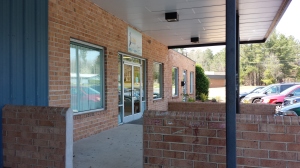***Disclaimer: the school in Durham mentioned in this post is disguised. It’s real name is not mentioned for privacy reasons.
An independent building with brick walls, a spacious entrance, and a wide grassy field for students to run around and play on; these are what I expect most schools to have. My recent visit to a school in Durham proved how little I knew of the varying school facilities in the United States. My expectations for western schools were built off of my experiences at international schools that I was extremely fortunate to have attended. Both Taipei American School and Gyeonggi Suwon International School have relatively new and clean facilities. The exterior of both schools were exceptional: both have a safe and large playground for younger students, and they each have a well-rounded sports complex. TAS has a proper running track, a gym with basketball and volleyball courts, and even a golfing area. Likewise, GSIS had a gym with a tennis court and a swimming pool. Both have a wide grassy field where students spend their recesses playing soccer or gymnastics. I thought all schools had these qualities, especially in the United States. Moreover, schools depicted in movies or tv shows that I’ve watched also had at least some of these features.
The academy for preschool and elementary students that I visited was located in a corner of an extremely small version of a strip mall. The building was on a large grey asphalt floor, which was mostly used for parking spaces. There was a small Mediterranean grill and grocery store in the middle. At first, my teammates and I had a hard time finding the school itself. We drove around the area a few times and even walked around the building to look for it. It wasn’t until later that we found the school on the right corner with a small sign that read Aladdin Academy. The entrance was very simple: through the wide glass doors, I saw a desk with a computer on it, which seemed like the reception area. On the other side of the building, there was a small playground for students. But it was also on hard asphalt floor. There were no sign of sports facilities. I wasn’t able to go into the school that day, so my observation is limited to the exterior of the school. This got me wondering whether school structures and facilities influenced students’ learning.
Recent studies have shown a relatively small but steady correlation between school facilities and education. A school’s physical structure can affect people in multiple psychological ways. First, a good building keeps employers motivated, while an “ugly” building makes them want to escape. This sways teachers’ incentive to teach and work with students in classrooms. Second, school buildings function as a symbol, especially to students. A high standard of maintenance gives students confidence and pride. It gives the sense of safety and protection where students are welcomed to pursue their academics. A study proved that elementary students aged 9 to 11 were more likely than adults to identify dirty classrooms, dirty bathrooms, and certain unwelcoming colors of painted walls. Schools can also increase community pride and prompt higher community participation in academics and school events to improve scholastic pursuits. Given these psychological factors, an unkempt school indicates that the school authorities accept low performance and have low expectations for students.
The physical building and its maintenance of schools result in differing achievement ratings, graduation rates, dropout rates, and teacher turnout. Schools with newer and cleaner facilities produce students with higher academic achievements whose graduation rates are much higher. Students in schools with better science laboratories score higher in math and science assessments than students with weak science labs. On the other hand, schools that require frequent facilities repair have higher student absenteeism and dropout rates.
While most studies point to socioeconomic backgrounds and family interactions as the most influential factors in students’ academic performances, these are outside the leagues of teachers and school administrators. This study sends a hopeful message that a renovation of school buildings and classrooms can dramatically change students’ perception of their learning environment and thus their achievements.
Although the Aladdin Academy did not have the best of school facilities, I don’t mean to judge their quality of education. I have not been able to observe classes or the interior of the school, nor have I seen student-teacher interactions in class. Most importantly, I am by no means an expert on school assessments. I’m sure the school provides exceptional cultural and academic opportunities for its students. My sole intention of describing the academy was to establish a stark contrast between my falsely built stereotype of schools in the United States and reality and to chastise my own naïveté.
But these studies on the effect of school facilities on student achievement show that teachers and administrators do not have to stand by helplessly at the irreversible socioeconomic forces that have come to define students’ academic performances.
Jinni
Sources
- http://www.state.tn.us/tacir/PDF_FILES/Education/SchFac.pdf
- http://www.21csf.org/best-home/docuploads/pub/210_Lit-Review-LetterSize-Final.pdf
Additional Reading Material


I think appearance and structure of schools is very important and often overlooked. I went to a high school that was of generally low SES, and actually somewhat ugly exterior and interior. We didn’t have nice science labs/classrooms, our cafeteria was so small that we had to do different shifts of lunch, we had extra units on the outside since we had run out of classroom space inside the building, the parking lot wasn’t very nice, and the school looked old. Not welcoming at all. I think if students are able to go to schools that are newer and clean, welcoming, and have aesthetic appeal, they will enjoy school more. Students will be more willing to go to school if it is nice and not dilapidated! However, money is usually the issue.
LikeLike